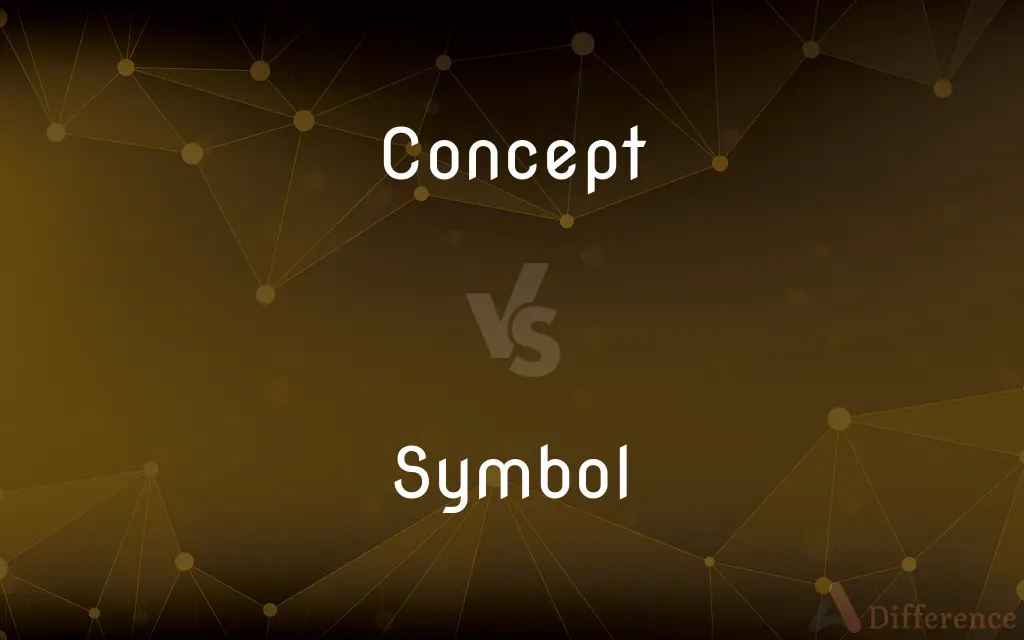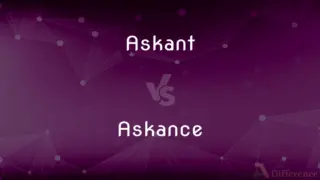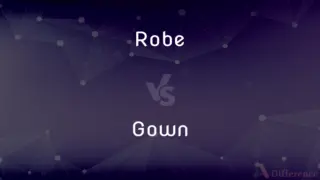Concept vs. Symbol — What's the Difference?
By Tayyaba Rehman & Maham Liaqat — Updated on April 22, 2024
A concept is an abstract idea or a general notion that exists in the mind as an understanding or thought, while a symbol is a tangible representation used to signify ideas, concepts, or other entities through visual, verbal, or other means.

Difference Between Concept and Symbol
Table of Contents
ADVERTISEMENT
Key Differences
A concept is an abstract idea that represents a fundamental understanding of phenomena, encompassing generalizations or categorizations of objects, events, or qualities. Concepts exist primarily in the mind and are used to grasp the essence of what is observed in the world. In contrast, a symbol is a physical or tangible representation that stands for or suggests another entity, idea, or relationship through association, resemblance, or convention.
Concepts are used to process and organize information, enabling complex thought and communication. They can be broad, like 'justice' or 'equality', requiring deep understanding and interpretation. Symbols, however, are more concrete, serving as visual or auditory cues that convey ideas, values, or beliefs, such as a flag representing a country or a cross symbolizing Christianity.
While concepts are not tied to any specific cultural or physical form, symbols are often culturally specific, holding different meanings within different contexts. A concept remains consistent across different scenarios as it is a mental construct, whereas a symbol's interpretation can vary widely depending on its cultural or situational context.
In the realm of communication, concepts form the basis of knowledge and understanding, discussed and elaborated in academic, personal, or professional dialogues. Symbols are used more directly in everyday life and arts, often encapsulating complex concepts in a form that can be easily recognized and understood by others.
The development of concepts can be a dynamic process that evolves with new information or through intellectual discourse. Symbols, while also capable of evolving, tend to have more static meanings once established but can be repurposed or imbued with new meanings over time.
ADVERTISEMENT
Comparison Chart
Nature
Abstract, mental.
Tangible, representational.
Function
Organize and categorize thoughts.
Represent or stand for other entities.
Cultural Ties
Universally applicable.
Culturally specific meanings.
Usage
In theory, discourse, education.
In communication, arts, identification.
Flexibility
Evolves with understanding.
Often fixed, but can evolve symbolically.
Compare with Definitions
Concept
Used to categorize and understand phenomena.
The concept of species helps biologists classify organisms.
Symbol
A representation of a broader idea.
A dove is commonly used as a symbol of peace.
Concept
An abstract idea.
The concept of freedom is central to many political ideologies.
Symbol
Fixed in meaning but can evolve.
The color green symbolizes nature but has also come to represent eco-friendly practices.
Concept
Fundamental to theories and discussions.
Economic concepts like supply and demand are crucial to market analysis.
Symbol
Culturally significant.
The lotus flower is a powerful symbol in Eastern religions.
Concept
Broad and universally applicable.
The concept of love is recognized in various forms around the world.
Symbol
Visual or auditory signifier.
A national anthem is a symbolic representation of a country's identity.
Concept
Concepts are defined as abstract ideas or general notions that occur in the mind, in speech, or in thought. They are understood to be the fundamental building blocks of thoughts and beliefs.
Symbol
Employed in various forms of communication.
Traffic lights use colors as symbols to regulate driver behavior.
Concept
Not visually representable.
The concept of time cannot be seen but is understood through its effects.
Symbol
A symbol is a mark, sign, or word that indicates, signifies, or is understood as representing an idea, object, or relationship. Symbols allow people to go beyond what is known or seen by creating linkages between otherwise very different concepts and experiences.
Concept
An abstract idea
Structuralism is a difficult concept
The concept of justice
Symbol
A mark or character used as a conventional representation of an object, function, or process, e.g. the letter or letters standing for a chemical element or a character in musical notation
The chemical symbol for helium is He
The symbol r in Figure 5 represents a gene which is ineffective
Concept
A general idea or understanding of something
The concept of inertia.
The concept of free will.
Symbol
A thing that represents or stands for something else, especially a material object representing something abstract
The limousine was another symbol of his wealth and authority
Concept
A plan or original idea
The original concept was for a building with 12 floors.
Symbol
Symbolize.
Concept
A unifying idea or theme, especially for a product or service
A new restaurant concept.
Symbol
Something that represents something else by association, resemblance, or convention, especially a material object used to represent something invisible
The lamb is a symbol of innocence.
Concept
Having an experimental or strikingly different design, especially to test or demonstrate new features
A concept car.
Symbol
An instance that typifies a broader pattern or situation
His striking out to end the rally was a symbol of everything that had gone wrong with the team over the past month.
Concept
An abstract and general idea; an abstraction.
Symbol
A printed or written sign used to represent an operation, element, quantity, quality, or relation, as in mathematics or music.
Concept
Understanding retained in the mind, from experience, reasoning and imagination; a generalization (generic, basic form), or abstraction (mental impression), of a particular set of instances or occurrences (specific, though different, recorded manifestations of the concept).
Symbol
(Psychology) An object or image that an individual unconsciously uses to represent repressed thoughts, feelings, or impulses
A phallic symbol.
Concept
(generic programming) A description of supported operations on a type, including their syntax and semantics.
Symbol
A character or glyph representing an idea, concept or object.
$ is the symbol for dollars in the US and some other countries.
Chinese people use word symbols for writing.
Concept
To conceive; to dream up
Symbol
A thing considered the embodiment of a concept or object.
The lion is the symbol of courage; the lamb is the symbol of meekness or patience.
Concept
An abstract general conception; a notion; a universal.
The words conception, concept, notion, should be limited to the thought of what can not be represented in the imagination; as, the thought suggested by a general term.
Symbol
(linguistics) A type of noun whereby the form refers to the same entity independently of the context; a symbol arbitrarily denotes a referent. See also icon and index.
Concept
An abstract or general idea inferred or derived from specific instances
Symbol
A summary of a dogmatic statement of faith.
The Apostles, Nicene Creed and the confessional books of Protestantism, such as the Augsburg Confession of Lutheranism are considered symbols.
Symbol
(crystallography) The numerical expression which defines a plane's position relative to the assumed axes.
Symbol
(obsolete) That which is thrown into a common fund; hence, an appointed or accustomed duty.
Symbol
(obsolete) Share; allotment.
Symbol
(programming) An internal identifier used by a debugger to relate parts of the compiled program to the corresponding names in the source code.
Symbol
(telecommunications) A signalling event on a communications channel; a signal that cannot be further divided into meaningful information.
Symbol
To symbolize.
Symbol
A visible sign or representation of an idea; anything which suggests an idea or quality, or another thing, as by resemblance or by convention; an emblem; a representation; a type; a figure; as, the lion is the symbol of courage; the lamb is the symbol of meekness or patience.
A symbol is a sign included in the idea which it represents, e. g., an actual part chosen to represent the whole, or a lower form or species used as the representative of a higher in the same kind.
Symbol
Any character used to represent a quantity, an operation, a relation, or an abbreviation.
Symbol
An abstract or compendium of faith or doctrine; a creed, or a summary of the articles of religion.
Symbol
That which is thrown into a common fund; hence, an appointed or accustomed duty.
They do their work in the days of peace . . . and come to pay their symbol in a war or in a plague.
Symbol
Share; allotment.
The persons who are to be judged . . . shall all appear to receive their symbol.
Symbol
An abbreviation standing for the name of an element and consisting of the initial letter of the Latin or New Latin name, or sometimes of the initial letter with a following one; as, C for carbon, Na for sodium (Natrium), Fe for iron (Ferrum), Sn for tin (Stannum), Sb for antimony (Stibium), etc. See the list of names and symbols under Element.
Symbol
To symbolize.
Symbol
An arbitrary sign (written or printed) that has acquired a conventional significance
Symbol
Something visible that by association or convention represents something else that is invisible;
The eagle is a symbol of the United States
Common Curiosities
How do concepts influence our understanding?
Concepts help structure our thoughts, allowing us to categorize and make sense of information.
How are concepts used in education?
Concepts are foundational in education, used to build knowledge structures and facilitate learning across disciplines.
Can a symbol exist without a concept?
Typically, symbols are linked to concepts as they represent or stand for underlying ideas or entities.
What is the primary difference between a concept and a symbol?
A concept is an abstract idea or notion, while a symbol is a concrete representation used to signify or represent something else.
What role do symbols play in communication?
Symbols streamline communication, conveying complex ideas quickly and effectively.
Why are symbols important in culture?
Symbols carry significant cultural meanings, facilitating communication and expressing identity and values.
Are concepts the same across different cultures?
While the basic idea of a concept may remain the same, its interpretation or implications can vary across cultures.
What is an example of a concept becoming a symbol?
The concept of peace has been symbolized by the olive branch in many cultures.
How does one create a new symbol?
Creating a new symbol involves establishing a visual, verbal, or auditory sign that effectively communicates a particular idea or concept.
Can the meaning of a symbol change over time?
Yes, symbols can evolve and their meanings can change or expand in different cultural or historical contexts.
How do symbols enhance storytelling?
Symbols add depth and layers of meaning, enhancing thematic richness and resonance in storytelling.
Is a logo a symbol?
Yes, a logo is a type of symbol used primarily for branding and identifying businesses or products.
What is the impact of digital media on symbols?
Digital media have expanded the use and recognition of symbols, making them more universally accessible and often altering their traditional meanings.
Can a person be a symbol?
Yes, individuals can become symbols representing broader ideas or movements, like Martin Luther King Jr. symbolizing civil rights.
Why might a concept be misinterpreted?
Concepts might be misinterpreted due to differences in cultural background, education, or personal experiences.
Share Your Discovery

Previous Comparison
Askant vs. Askance
Next Comparison
Robe vs. GownAuthor Spotlight
Written by
Tayyaba RehmanTayyaba Rehman is a distinguished writer, currently serving as a primary contributor to askdifference.com. As a researcher in semantics and etymology, Tayyaba's passion for the complexity of languages and their distinctions has found a perfect home on the platform. Tayyaba delves into the intricacies of language, distinguishing between commonly confused words and phrases, thereby providing clarity for readers worldwide.
Co-written by
Maham Liaqat













































